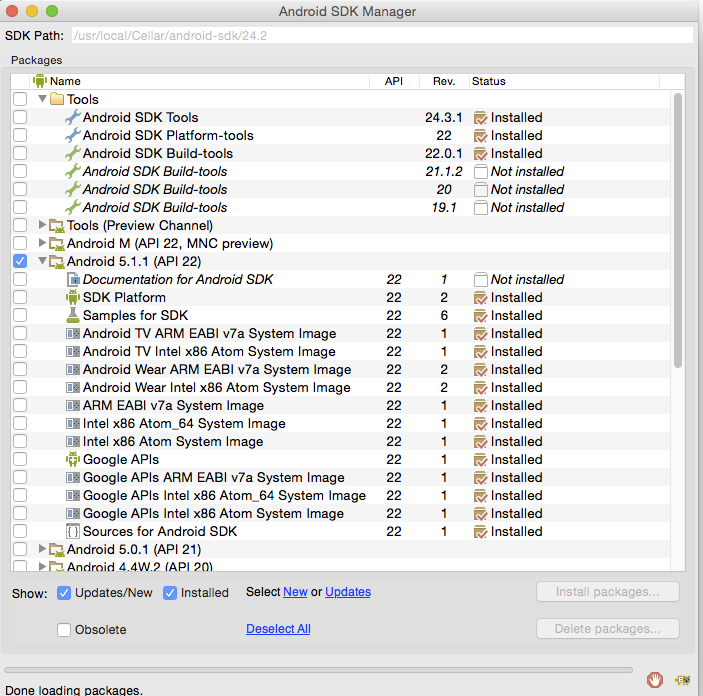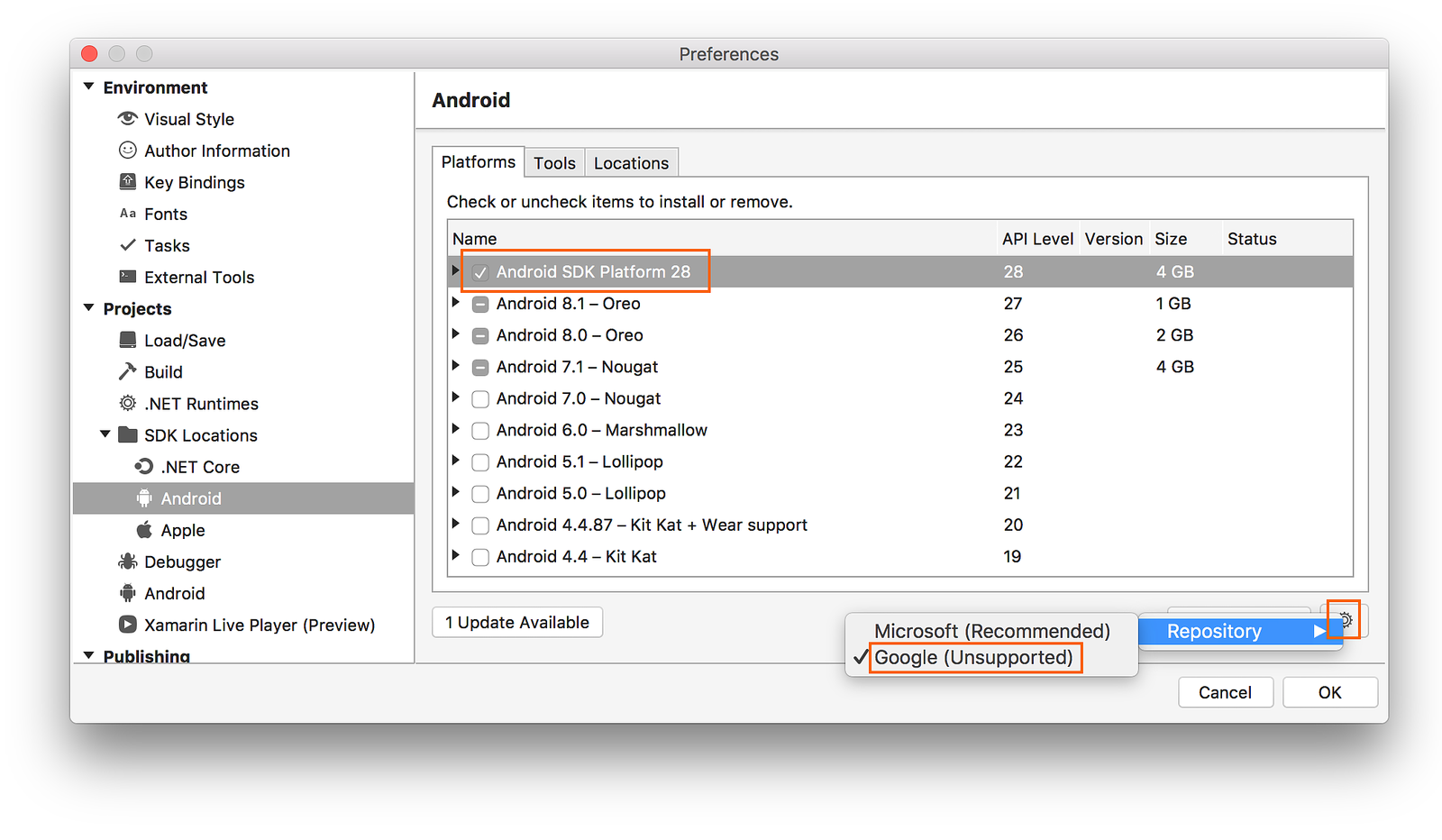Imagine your playing an Android game, you’re winning already but ended losing because of some minor problem caused by a fixable bug. Naturally, you’ll get frustrated and irritated by the fact that the game’s developers will take a few more months (or years) to release the next update. Thanks to Google’s Android SDK, you can now personally (and manually) fix, profile, and develop your own Android applications. Most importantly, it is provided free for everyone who needed tools to work with Android from a computer. Although, this one needs a lot of your patience since it requires a higher set of skills in order to utilize its features. But is it really worth your time?
A reliable toolset for creating and updating Android applications
.NET 5.0 downloads for Linux, macOS, and Windows.NET is a free, cross-platform, open-source developer platform for building many different types of applications. Android SDK Platform Tools download is now available as a zip file directly from Google. Just download the latest SDK platform-tools zip containing ADB and Fastboot binaries for Windows, Mac, and Linux from below and unzip it.
You don't need to wait for the updates when you can do it yourself.
Android SDK is a toolset that enables developers to create and update different apps for Android devices. It gives mobile software developers the opportunity to manually fix, text, profile, debug, and update their own software within the same platform. This toolset includes a debugger, an emulator, Application Programming Interfaces (APIs), sample projects with source code as well as the required libraries to build Android apps. These tools are platform-independent and are essential in creating Android apps, regardless of the version you are working for. Most importantly, it comes with an emulated virtual device that is fully functional that allows you to test out your work in progress.
Now that you have a basic knowledge about the toolset, you should also understand that even if it contains almost everything you need to create and further develop an Android software, it still needs the support of other important command-line tools such as Platform tools, and the Android Emulator, in order for you to get started.
Platform tools
These tools are customized and used to support new features of Android’s latest version, as well as the prior versions. It works along with Build tools for encryption, security, and file size purposes. One of the tools included in this group is the Android Debug Bridge (adb). It can be used to install an Android app file on any of your devices and allows you to access additional shell tools like bmgr and logcat.
Android emulator
This emulator is a QEMU-based device-emulation tool that allows you to debug and test your apps in an actual Android runtime environment even without using any physical devices. Running the emulator will require you to have a system image, an additional tool to your toolset. Each platform version contains the supported system images. You can download these system images while creating Android Virtual Devices (AVDs) within its manager. Simply select either Intel or ARM-based on your development computer’s processor.

Android SDK platform
To compile your apps, you’re required to have at least one platform in your environment. While to provide the best user experience on your latest devices, you’ll need to have the latest platform version as your build target. You’ll still be able to run your app on older versions but you must build against the latest version in order to utilize new functions featured when running on devices with the latest OS version.
In order to properly run this set of tools, you’ll need an Integrated Development Environment (IDE). Although the SDK can be used to write programs in the command prompt, the most common method is by using an IDE. This is where Android Studio comes in, it allows you to compile and edit your code, or test your app before releasing it on Google Play. Installing Android Studio is also the easiest way to get a working set of tools on your PC. It will also keep your Android SDK tools up to date with its automatic updates and the Android SDK Manager.
This set of Android development tools is easy to set up and run. Its user interface is a little bit blunt and traditional but it’s also straightforward and intuitive. The whole process using this toolset is not intuitive enough for novice app developers. However, there are lots of available documentation and tutorials online that can help in assisting you in using Android SDK.
Where can you run this program?
You can download the toolset for free. It is highly compatible with Windows (recommended), Mac OS X, and Linux. There are two ways to get a copy of the toolset’s compressed file. The first one requires you to download the whole Android Studio file which already contains the toolset (and other Android development tools). While the other one is way more complex than the first one. You can download the zip file easily but setting it to your computer varies from the OS you’re using. But no need to worry since step-by-step tutorials are available online.
Is there a better alternative?
There are a lot of alternative options you can download online for free. In case you’re thinking of creating games for Android devices, Unity 3D is your best bet. It is a game engine and IDE for cross-platform game development. It is also user-friendly which makes it highly recommendable for everyone--either you're a beginner or a professional developer. It comes with multiple features you can easily master. Unlike Android SDK, this IDE makes your development process much easier and will help you save a considerable amount of time and headaches. It is currently best for 2D games, but you can also utilize it also to create virtual reality apps for Daydream, Cardboard, and the Gear VR. While if you’re looking for a powerful, all-around IDE which supports a wide range of languages including C#, VB.net, JavaScript, and more--then try Microsoft’s Visual Studio.
Our take
Android SDK will allow you to experience a fast and reliable development environment which will definitely give you more reasons to work hard with your projects. It’s more likely a playground for professionals rather than a paradise for beginners since using it will require you adequate knowledge about the app development process. On the other hand, having it for free will help you save a considerable amount of money. Using it will allow you to fix and make necessary improvements to certain Android apps without the trouble of waiting for the developers to finally release the updates.
Should you download it?
Yes. Since it’s efficiently fast, reliable, and especially trust-worthy solely for the reason it’s created by Google. Although it’s free, there are other (better) alternatives out there for you to explore such as Unity 3D and Visual Studio.
3.0.1
-->Visual Studio includes an Android SDK Manager that you useto download Android SDK tools, platforms, and other components that youneed for developing Xamarin.Android apps.
Overview
This guide explains how to use the Xamarin Android SDK Manager inVisual Studio and Visual Studio for Mac.
Note
This guide applies to Visual Studio 2019, Visual Studio 2017, and Visual Studio for Mac.
The Xamarin Android SDK Manager (installed as part of the Mobiledevelopment with .NET workload) helps you download the latest Androidcomponents that you need for developing your Xamarin.Android app. Itreplaces Google's standalone SDK Manager, which has been deprecated.
Requirements
To use the Xamarin Android SDK Manager, you will need the following:
Visual Studio 2019 Community, Professional, or Enterprise.
OR Visual Studio 2017 (Community, Professional, or Enterprise edition). VisualStudio 2017 version 15.7 or later is required.
Visual Studio Tools for Xamarin version 4.10.0 or later(installed as part of the Mobile development with .NET workload).
The Xamarin Android SDK Manager also requires the Java Development Kit(which is automatically installed with Xamarin.Android). There areseveral JDK alternatives to choose from:
By default, Xamarin.Android usesJDK 8,which is required if you are developing for API level 24 or greater(JDK 8 also supports API levels earlier than 24).
You can continue to use JDK 7if you are developing specifically for API level 23 or earlier.
If you are using Visual Studio 15.8 Preview 5 or later, you can tryusing Microsoft's Mobile OpenJDK Distributionrather than JDK 8.
SDK Manager
To start the SDK Manager in Visual Studio, click Tools > Android >Android SDK Manager:
The Android SDK Manager opens in the Android SDKs andTools screen. This screen has two tabs – Platforms andTools:
The Android SDKs and Tools screen is described in more detail inthe following sections.
Android SDK location
The Android SDK location is configured at the top of the Android SDKsand Tools screen, as seen in the previous screenshot. This location mustbe configured correctly before the Platforms and Tools tabswill function properly. You may need to set the location of the AndroidSDK for one or more of the following reasons:
The Android SDK Manager was unable to locate the Android SDK.
You have installed the Android SDK in a alternate (non-default) location.
To set the location of the Android SDK, click the ellipsis (…)button to the far right of Android SDK Location. This opens theBrowse For Folder dialog to use for navigating to the location ofthe Android SDK. In the following screenshot, the Android SDK underProgram Files (x86)Android is being selected:
When you click OK, the SDK Manager will manage the Android SDK thatis installed at the selected location.
Tools tab
The Tools tab displays a list of tools and extras. Use this tabto install the Android SDK tools, platform tools, and build tools.Also, you can install the Android Emulator, the low-level debugger(LLDB), the NDK, HAXM acceleration, and Google Play libraries.
For example, to download the Google Android Emulator package, click thecheck mark next to Android Emulator and click the Apply Changesbutton:
A dialog may be shown with the message, The following package requiresthat you accept its license terms before installing:
Click Accept if you accept the Terms and Conditions. At the bottomof the window, a progress bar indicates download and installationprogress. After the installation completes, the Tools tab will showthat the selected tools and extras were installed.
Platforms tab
The Platforms tab displays a list of platform SDK versions alongwith other resources (like system images) for each platform:
This screen lists the Android version (such as Android 8.0), thecode name (Oreo), the API level (such as 26), and the sizes ofthe components for that platform (such as 1 GB). You use thePlatforms tab to install components for the Android API level thatyou want to target. For more information about Android versions and APIlevels, seeUnderstanding Android API Levels.
When all components of a platform are installed, a checkmark appears nextto the platform name. If not all components of a platform areinstalled, the box for that platform is filled.You can expand a platform to see its components (and which componentsare installed) by clicking the + box to the left of the platform.Click - to unexpand the component listing for a platform.
To add another platform to the SDK, click the box next to the platformuntil the checkmark appears to install all of its components, thenclick Apply Changes:
To install only specific components, click the box next to the platformonce. You can then select any individual components that you need:
Notice that the number of components to install appears next to theApply Changes button. After you click the Apply Changes button,you will see the License Acceptance screen as shown earlier.Click Accept if you accept the Terms and Conditions. You may seethis dialog more than one time when there are multiple components toinstall. At the bottom of the window, a progress bar will indicatedownload and installation progress. When the download and installationprocess completes (this can take many minutes, depending on how manycomponents need to be downloaded), the added components are marked witha checkmark and listed as Installed.

Repository selection


By default, the Android SDK Manager downloads platform components andtools from a Microsoft-managed repository. If you need access toexperimental alpha/beta platforms and tools that are not yet availablein the Microsoft repository, you can switch the SDK Manager to useGoogle's repository. To make this switch, click the gear icon in thelower right-hand corner and select Repository > Google(Unsupported):
When the Google repository is selected, additional packages may appearin the Platforms tab that were not available previously. (In theabove screenshot, Android SDK Platform 28 was added by switching tothe Google repository.) Keep in mind that use of the Google repositoryis unsupported and is therefore not recommended for everydaydevelopment.
To switch back to the supported repository of platforms and tools,click Microsoft (Recommended). This restores the list of packagesand tools to the default selection.
Requirements
To use the Xamarin Android SDK Manager, you will need the following:
- Visual Studio for Mac 7.5 (or later).
The Xamarin Android SDK Manager also requires the Java Development Kit(which is automatically installed with Xamarin.Android). There areseveral JDK alternatives to choose from:
By default, Xamarin.Android usesJDK 8,which is required if you are developing for API level 24 or greater(JDK 8 also supports API levels earlier than 24).
You can continue to use JDK 7if you are developing specifically for API level 23 or earlier.
If you are using Visual Studio for Mac 7.7 or later, you can tryusing Microsoft's Mobile OpenJDK Distributionrather than JDK 8.
Download Android Sdk For Unity Mac
Important
Xamarin.Android does not support JDK 9.

SDK Manager
To start the SDK Manager in Visual Studio for Mac, click Tools > SDK Manager:
The Android SDK Manager opens in the Preferences window, whichcontains three tabs, Platforms, Tools, and Locations:
The tabs of the Android SDK Manager are described in thefollowing sections.
Locations tab
The Locations tab has three settings for configuring the locationsof the Android SDK, Android NDK, and the Java SDK (JDK). Theselocations must be configured correctly before the Platforms andTools tabs will function properly.
When the SDK Manager starts, it automatically determines the path foreach installed package and indicates that it was Found by placing agreen checkmark icon next to the path:
Click the Reset to Defaults button to cause the SDK Manager to lookfor the SDK, NDK, and JDK at their default locations.
Typically, you use the Locations tab to modify the location of theAndroid SDK and/or the Java JDK. You do not need to install the NDK todevelop Xamarin.Android apps – the NDK is used only when you needto develop parts of your app using native-code languages such as C andC++.
Download Android Sdk For Mac
Tools tab
The Tools tab displays a list of tools and extras. Use this tabto install the Android SDK tools, platform tools, and build tools.Also, you can install the Android Emulator, the low-level debugger(LLDB), the NDK, HAXM acceleration, and Google Play libraries.
For example, to download the Google Android Emulator package, click thecheck mark next to Android Emulator and click the Apply Changesbutton:
A dialog may be shown with the message, The following package requiresthat you accept its license terms before installing:
Click Accept if you accept the Terms and Conditions. At the bottomof the window, a progress bar indicates download and installationprogress. After the installation completes, the Tools tab will showthat the selected tools and extras were installed.
Platforms tab
The Platforms tab displays a list of platform SDK versions alongwith other resources (like system images) for each platform:
Download Android Sdk Windows 64 Bit
This screen lists the Android version (such as Android 8.1), thecode name (Oreo), the API level (such as 27), and the sizes ofthe components for that platform (such as 1 GB). You use thePlatforms tab to install components for the Android API level thatyou want to target. For more information about Android versions and APIlevels, see Understanding Android API Levels.
When all components of a platform are installed, a checkmark appears nextto the platform name. If not all components of a platform areinstalled, the box for that platform is filled.You can expand a platform to see its components (and which componentsare installed) by clicking the arrow to the left of the platform.Click down arrow to unexpand the component listing for a platform.
To add another platform to the SDK, click the box next to the platformuntil the checkmark appears to install all of its components, thenclick Apply Changes:
To install only some components, click the box next to the platformonce. You can then select any individual components that you need:
Notice that the number of components to install appears next to theApply Changes button. After you click the Apply Changes button,you will see the License Acceptance screen as shown earlier.Click Accept if you accept the Terms and Conditions. You may seethis dialog more than one time when there are multiple components toinstall. At the bottom of the window, a progress bar will indicatedownload and installation progress. When the download and installationprocess completes (this can take many minutes, depending on how manycomponents need to be downloaded), the added components are marked witha checkmark and listed as Installed.
Repository selection
By default, the Android SDK Manager downloads platform components andtools from a Microsoft-managed repository. If you need access toexperimental alpha/beta platforms and tools that are not yet availablein the Microsoft repository, you can switch the SDK Manager to useGoogle's repository. To make this switch, click the gear icon in thelower right-hand corner and select Repository > Google(Unsupported):
When the Google repository is selected, additional packages may appearin the Platforms tab that were not available previously. (In theabove screenshot, Android SDK Platform 28 was added by switching tothe Google repository.) Keep in mind that use of the Google repository isunsupported and is therefore not recommended for everyday development.
To switch back to the supported repository of platforms and tools,click Microsoft (Recommended). This restores the list of packagesand tools to the default selection.
Summary
Download Android Sdk For Mac Offline
This guide explained how to install and use the Xamarin Android SDKManager tool in Visual Studio and Visual Studio for Mac.